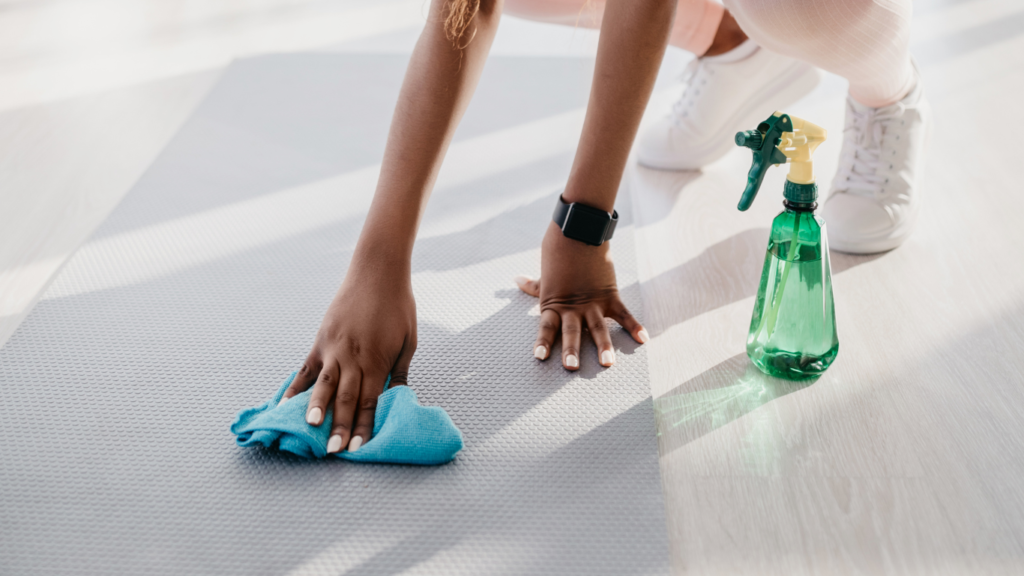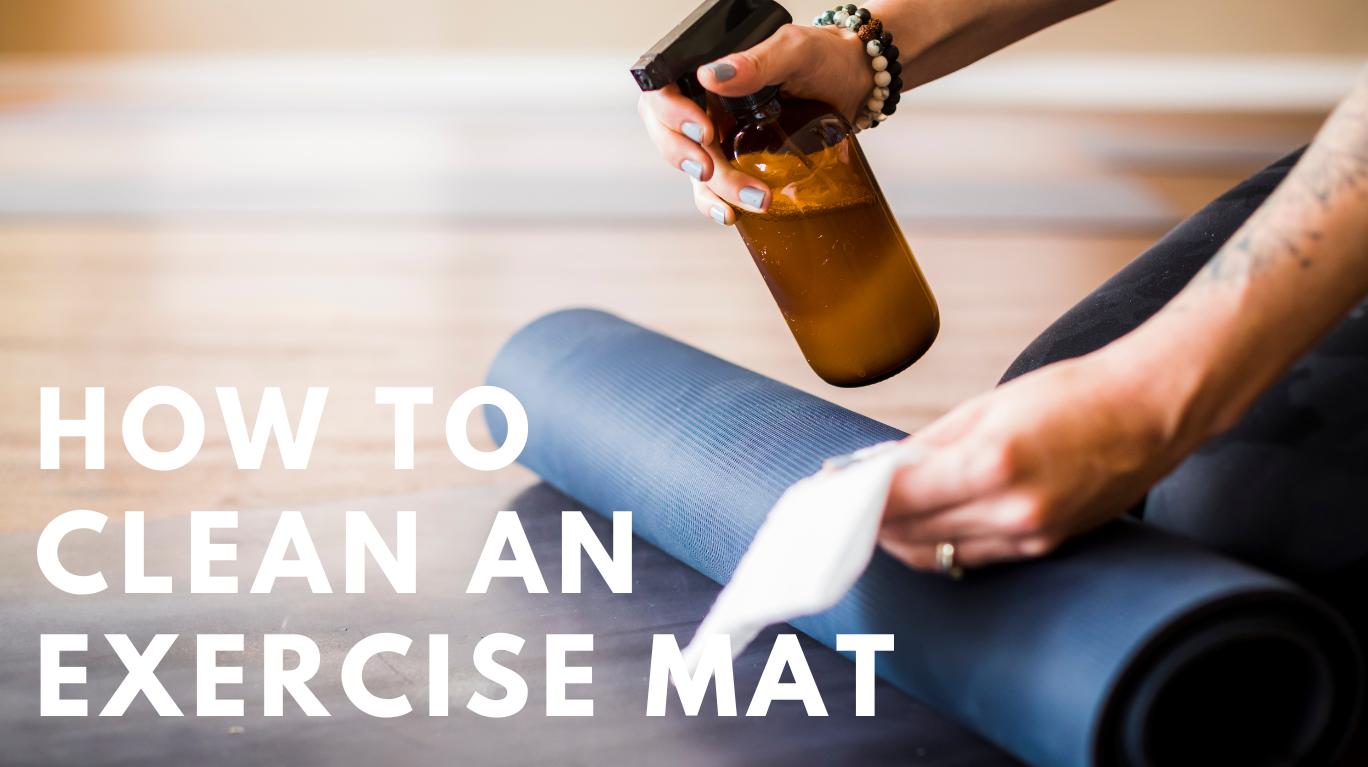Are you tired of working out on a funky-smelling, gunk-covered exercise mat? It’s time to put an end to the icky and embrace the clean. In this article, we’re going to show you how to clean an exercise mat, tackle the grime, and reveal the secret to a fresh and hygienic surface.
Say goodbye to sweat stains and germs, and say hello to a mat that feels brand new every time you step on it. Ready to roll up your sleeves and make your workouts cleaner than ever? Let’s get cleaning!
Understanding Exercise Mats: Types, Materials, and Cleaning Tips
There are various types of exercise mats available, each serving different purposes. Common types include yoga mats, Pilate mats, and general fitness mats. These mats come in different materials like PVC, rubber, foam, or cork. It’s crucial to choose the one that suits your exercise routine and provides sufficient support and comfort.
Over time, exercise mats can accumulate sweat, oils, dirt, and bacteria from frequent use. These dirty mats not only emit unpleasant odors but can also become a breeding ground for germs and infections. Sweating during workouts can also cause moisture to seep into the mat, leading to mold growth, which can be harmful to your health. So cleaning your mat regularly is vital to maintain hygiene and extend its lifespan.
When it comes to cleaning your exercise mat, it’s essential to use the right cleaning products to maintain its quality and hygiene. Here are some useful tips to consider before selecting cleaning products:
- Check if the product is safe for your mat material.
- Choose eco-friendly and non-toxic options for your health and the environment.
- Get products with anti-bacterial properties to kill germs and odors.
- Pick easy-to-use products that save time and effort while cleaning.
Thus to keep your workout area clean and pleasant, it’s essential to know about different exercise mats and their materials. Also, be aware of the problems that dirty mats can cause. Choose the right cleaning products to maintain a hygienic and comfortable space. This way, you’ll have a more enjoyable and rewarding fitness experience.
How to Clean an Exercise Mat: Regular Cleaning Routine
Regularly cleaning your exercise mat is essential for hygiene and prolonging usability. Whether you prefer hand-washing or using a washing machine, our guidelines will help you to remove dirt, sweat, and germs from your exercise mat and keep it fresh and ready for your next workout. Let’s dive in!
Pre-cleaning Preparation
- Shake off the mat to remove loose dirt, dust, and debris.
- Use a soft brush or cloth to gently brush away any remaining particles.
- Pick a well-ventilated area with enough space to clean and dry the mat properly.
- Avoid areas with direct sunlight as it may damage the mat’s material.
Hand-washing Your Exercise Mat
- In a large bucket, mix warm water with a mild detergent or a few drops of dish soap.
- Avoid using harsh chemicals or bleach, as they may damage the mat’s surface.
- Dip a clean cloth or sponge into the cleaning solution.
- Gently scrub the entire surface of the exercise mat, paying extra attention to soiled areas.
- Avoid using excessive force to prevent damaging the mat.
- Rinse the mat thoroughly with clean water to remove any soap residue.
- Squeeze out excess water without wringing the mat to maintain its shape.
- Lay the mat flat on a clean towel and roll it up to remove extra moisture.
- Unroll the mat and let it air dry in a well-ventilated area, away from direct sunlight.
Using a Washing Machine (If Applicable)
- Check the manufacturer’s guidelines to ensure the mat is machine washable.
- Some mats may lose their shape or texture when machine-washed, so hand-washing is often preferred.
- If your mat is machine washable, use a delicate or gentle cycle with cold water.
- Add a small amount of mild detergent to the washing machine.
- After machine washing, follow the same drying techniques mentioned in the hand-washing section.
- Never use a dryer or heater to speed up the drying process, as it may damage the mat.
Deep Cleaning and Stain Removal of an Exercise Mat
Deep cleaning and stain removal are important steps to ensure your mat stays fresh and free from unwanted marks. In this section, we’ll guide you through the process using simple steps and everyday materials.

Step 1: Gather Supplies
- Soft brush or sponge
- Mild soap or detergent
- Warm water
- White vinegar
- Towel or cloth
- Spray bottle
- Baking soda (for stain removal)
Step 2: Deep Cleaning
Soap and Water Method
- Fill a bucket or sink with warm water.
- Add a small amount of mild soap or detergent to the water.
- Dip the soft brush or sponge into the soapy water and scrub the entire mat gently.
- Pay special attention to the areas with visible stains or grime.
- Rinse the mat thoroughly with clean water to remove all soap residues.
Vinegar and Water Method (for odor removal)
- Mix equal parts of white vinegar and water in a spray bottle.
- Lightly spray the solution over the mat’s surface, focusing on areas that might have odors.
- Let it sit for a few minutes.
- Wipe down the mat with a damp cloth to remove the vinegar residue.
Step 3: Stain Removal
Baking Soda Method
- For tough stains, create a paste using baking soda and water.
- Apply the paste directly to the stained area.
- Gently scrub the stain using a soft brush or sponge.
- Allow the paste to sit on the stain for about 10-15 minutes.
- Rinse off the baking soda paste with clean water and towel dry the mat.
Step 4: Drying the Mat
- Lay the exercise mat flat on a dry towel or hang it over a clothesline.
- Allow the mat to air dry completely before rolling or storing it.
- Avoid direct sunlight or heat sources, as they can damage the mat’s material.
Step 5: Maintenance Tips
Here are some additional tips to keep in mind:
- Clean your exercise mat regularly, preferably after each use.
- Avoid using harsh chemicals or abrasive materials that may damage the mat’s surface.
- Store the mat in a clean and dry area when not in use.
Conclusion
In conclusion, knowing how to clean an exercise mat is of utmost importance for your health, hygiene, and overall exercise experience. Regular cleaning not only helps eliminate germs and bacteria but also extends the lifespan of your mat, saving you money in the long run. Developing a simple cleaning routine is easy and ensures that you can enjoy a clean and fresh mat every time you work out. By following the tips and steps provided in this article, you’ll have all the guidance you need to keep your exercise mat in top condition. So, take a moment to read through this article and start incorporating these cleaning practices into your fitness routine – your body will thank you!
Common Queries
What is the proper way to clean my exercise mat?
The proper way to clean an exercise mat is to use a mild detergent mixed with water. Gently scrub the mat with a soft cloth or sponge and then wipe it dry with a clean towel.
Are exercise mats machine-washable?
Not all exercise mats are machine-washable. Check the manufacturer’s instructions before attempting to machine wash your mat.
How often should your exercise mat be cleaned?
Your exercise mat should be cleaned regularly, ideally after each use or at least once a week, depending on how often you use it and how much you sweat.
What is the reason for cleaning your mat?
Cleaning your exercise mat is important to maintain hygiene, remove sweat, dirt, and bacteria and extend the mat’s lifespan.
Is it safe to apply vinegar on exercise mats?
It is generally safe to apply vinegar diluted with water on exercise mats, but it’s best to check the manufacturer’s guidelines first. Vinegar can help with disinfecting, but excessive use may damage certain mat materials.

